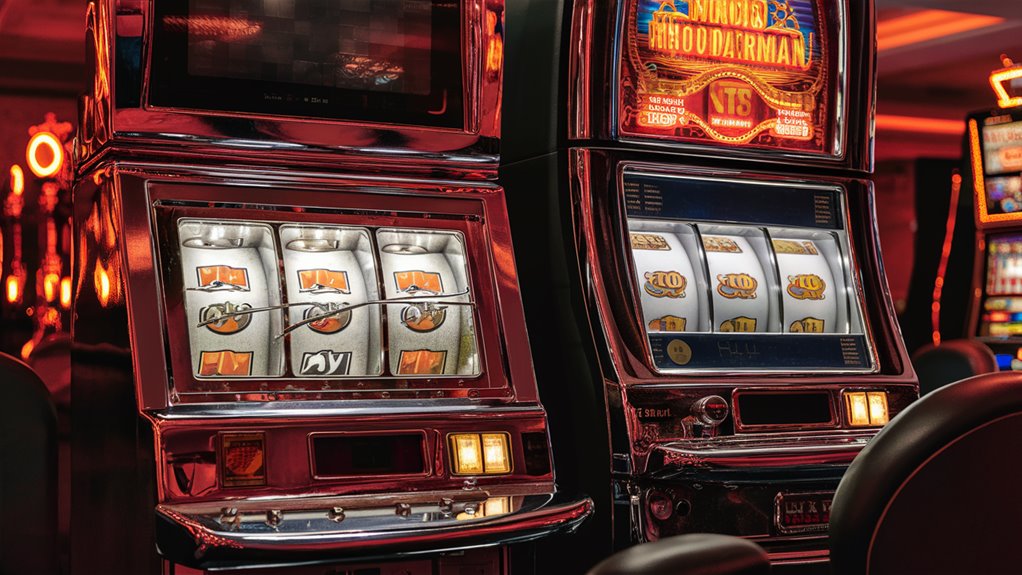How Slot Machines Boost Casino Money

Slot machines have become a significant aspect of casino revenue, integrating advanced technology and psychological strategies. Since their inception in 1895, these machines have evolved from mechanical devices to sophisticated digital systems, responsible for approximately 65-80% of casino revenue.
Tech Changes and Money Stats
Contemporary slot machines employ cutting-edge Random Number Generator (RNG) technology, multisensory feedback, and strategically timed rewards. These elements ensure a consistent 45-50% winning rate and impressive 60-70% profit margins per machine, making slots the most lucrative option on a casino floor.
Money Invested and Made
The financial aspect of slot machines demonstrates significant returns for casino operators. The initial investment ranges from $15,000 to $25,000 per machine, with a typical payback period of 12-18 months. Each machine generates $100 to $500 daily, ensuring high revenue per square foot of casino space.
The combination of psychological triggers, technological advancements, and intelligent payout strategies makes slots a cornerstone of any successful casino strategy.
Slot Machine History
From Gears to Digital: Slot Machine Growth
The First Gear Days (1895-1950)
The world of gaming transitioned with Charles Fey’s invention of the Liberty Bell in 1895, paving the way for modern slots.
These early mechanical games generated substantial revenue with basic slots maintaining average payouts at 60%. Their straightforward design and dependable returns established them as casino staples globally.
The Jump to Electromechanical (1960s-1980s)
The emergence of electromechanical slot machines marked a technological leap, increasing payout rates to 80-85%.
This advancement significantly reduced expenses, and care costs dropped by 40%. The new machines enabled casinos to expand their slot offerings, enhancing both revenue and player satisfaction.
The Shift to Digital (1990s-Now)
- Increased winning opportunities
- Interactive bonus rounds
- Diverse betting options from $0.25 to $1.00 per spin
- Engaging game themes
Today’s Gaming Tech
Now, digital slot setups feature:
- RFID player tracking
- Large jackpot systems
- State-of-the-art game engines managing 1,200 spins per hour
- Average playtimes of 2.5 hours per session
- Daily revenue between $200-500 per machine
This technological evolution has kept slots as the primary moneymaker, contributing over 70% of casino profits in major markets and increasing player engagement by 300% since 2000.
Modern Slot Tech
All About Today’s Slot Tech
Gaming Systems and Core Tech
Random Number Generators (RNGs) are integral to modern slots, generating millions of potential outcomes every second to ensure fair play.
Contemporary slots boast high-definition displays and immersive sound systems, enhancing player experiences and satisfaction.
New Pay and Manage Systems
TITO (Ticket-In-Ticket-Out) technology has revolutionized casino operations, reducing labor costs by 25% and increasing gameplay efficiency by 20%.
Server-based game platforms allow remote adjustments to payout rates and game themes, optimizing performance with real-time data insights.
Digital Joining and Player Fun
- Mobile connectivity is a central feature in modern slot design, with 40% of machines offering apps linked to player reward programs.
- Multi-game setups facilitate easy game switching, boosting machine utilization by 15%.
The introduction of skill-based content and social play has increased millennial interest by 30%, ensuring slots remain a dominant revenue source, generating 65-80% of floor income.
Money Made and Margins
Checking Casino Money and Profit

How Slots Make Money
Modern casino business strategies highlight enormous profit opportunities, with each slot machine earning $100-500 daily in total gaming revenue.
Statistics reveal that slots contribute 65-80% of all casino gaming revenue, yielding exceptional profit margins of 60-70% per unit after operational expenses.
Cash Setup and Getting It Back
The financial strategy for slot operations starts with an upfront capital requirement of $15,000-25,000 per unit. Operating costs are minimized, with a small team managing numerous machines.
Maintenance expenses account for only 2-3% of annual revenues. Thoughtfully calibrated payback rates of 85-98% are meticulously managed via programmable systems to enhance profitability while maintaining player engagement.
How Slots Do Against Other Games
Slot profits surpass traditional table games in revenue generation. While table games achieve 20-25% profit margins, slots provide far superior returns due to automated operations and reduced staffing requirements.
Return on Investment (ROI) analysis indicates that well-managed slot areas typically recoup their initial investment within 12-18 months, solidifying their role as key contributors to casino financial success.
Player Mind and Game Making
Player Mind in Game Making
Main Mind Ideas in Games
Gaming psychology influences player retention through meticulously crafted features that exploit human cognitive tendencies 메이저사이트
Variable reward schedules, near-misses, and loss aversion cultivate immersive gaming experiences that captivate players.
Advanced Slot Make-Up
Today’s slot design methodologies meticulously calibrate payout ratios, maintaining a 45-50% win probability throughout gaming sessions.
This dynamic win structure keeps players engaged with perfectly timed victories.
Multisensory feedback systems enhance gameplay enjoyment through synchronized sound and light displays, making minor wins feel more significant.
Game Tech Growing
New Ways to Win
Modern casino games incorporate innovative progressive gameplay elements inspired by video game mechanics. These features include:
- Unlockable bonus levels
- statistics that could determine your success
- Achievements for reaching game milestones
- Progressive levels
- Difficulty scaling based on player performance
Playing With Others
- Collaborative play features enhance player interaction through:
- Shared jackpot systems
- Linked progressive rewards
- Cooperative gaming
- Real-time leaderboards
These interactive elements show 20-30% higher retention rates compared to traditional game formats.
Social gaming features utilize psychological triggers such as FOMO (fear of missing out) to deepen player involvement.
Rules and Following Them
Game Rules and Sticking to Them
Rules of Games Around the World
Casino operations and gaming regulations are rapidly evolving on a global scale.
Nevada and New Jersey set benchmarks that other regions emulate.
Regulatory guidelines require stringent adherence to specific performance standards, with payout ratios ranging from 75% to 98%.
Costs and Needs to Follow Rules
Compliance consumes 15-20% of casino expenditures, encompassing software audits, hardware inspections, and continuous surveillance setups.
Contemporary slot technology must integrate with central reporting networks that monitor every wager, win, and technical issue.
Key compliance components include RNG certification, secure game configuration, and money laundering safeguards.
How Rules Change Game Wins
Well-regulated markets demonstrate superior game performance metrics.
Jurisdictions with comprehensive regulatory frameworks experience 23% higher player retention compared to less regulated areas.
Robust regulatory measures assist in achieving market leadership, fostering consistent revenue growth and enhanced market positioning. Casinos recognize that rigorous adherence to regulations results in sustained gaming success and stable market standing.
Main Rule Parts
- Technical Standards Verification
- Continuous Transaction Monitoring
- Implementation of Secure Gaming Protocols
- Anti-Money Laundering Procedures
- Routine System Evaluations
- Performance Testing and Validation
